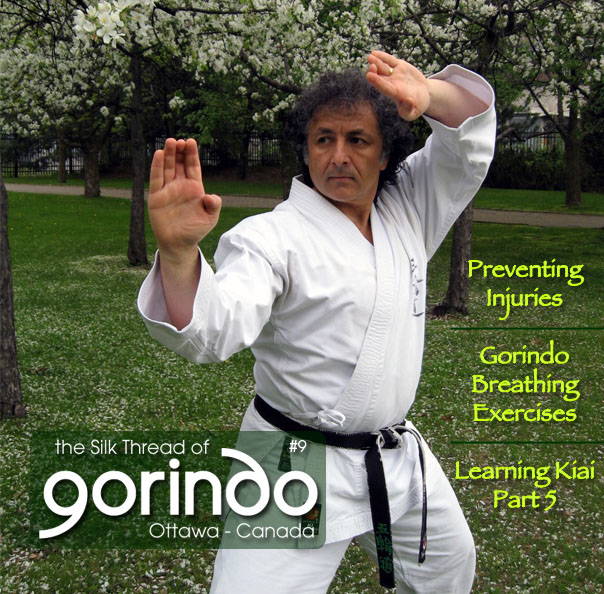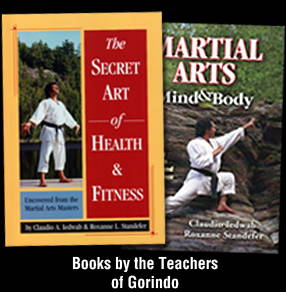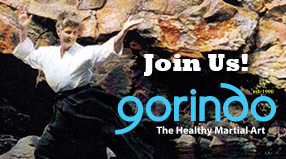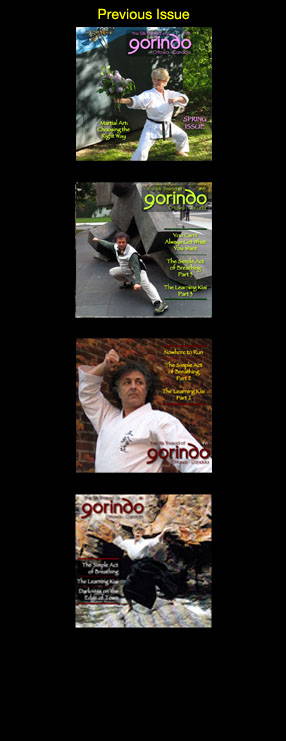
The Silk Thread of Gorindo - Ottawa - Canada
Issue 9
Photo cover Claudio Iedwab sensei by the Ottawa River, May 2011, by Roxanne Standefer
The Learning Kiai (Part 5)
< read Part 4 (previous issue)
Learning How to Learn
Martial art is about learning how to learn, and about getting the most out of your existence in the universe. With this understanding, the student will be able to learn from many sources and distill what is important and useful. This ability to distinguish will improve as the training proceeds and as long as it is kept in balance with nyuanshin, the student will be able to accept more and more of the responsibility for his own progress, and assist the teacher in helping others find their own way.
Teaching Others
At advanced levels students recognize that one of the best ways to learn more is to teach others. This is a fundamental tradition of the martial arts and a keystone of the learning methodology. Not only is it extremely rewarding and satisfying, and critical for the functioning of the dojo; it allows the senior student to look at the training from a fresh perspective, analyze questions that he might never have thought of posing himself, revisit the basics, and improve the accuracy of his own technique in demonstration. Most importantly though, he finds out what he does not know and where his understanding is weak, unclear or perhaps incorrect.
Exercising Patience and Maturity
Carrying an attitude that he has nothing more to learn, or that he has mastered that which he knows, is the death knell for the martial artist. No matter what his skill level, the practitioner with this condition will have more fear of showing mistakes than the white belt, and as a result his progress will stop, his interest will stagnate, and all the time, effort, and sweat put into the training will be wasted. This can happen to students who have not embraced nyuanshin, and for whatever reasons, have not come to terms with their strengths and weaknesses in an honest way.
 The beginner and expert must exercise patience and maturity, and find enjoyment in their day to day progress. This is another area where the traditional teachings of Zen and the Tao have relevance to the martial arts student.
The beginner and expert must exercise patience and maturity, and find enjoyment in their day to day progress. This is another area where the traditional teachings of Zen and the Tao have relevance to the martial arts student.
These philosophies can provide encouragement and support on a mental and spiritual level for some very physical challenges. The Learning Kiai has many aspects to it. Some are obvious and can be called upon readily, and others are more subtle and elusive. Part of the role of the teacher is to remind you of those elements you know, and awaken you to the ones you don’t yet employ. As we have discussed, having a positive and receptive attitude is one of the first and most important.
The nature of the training is very simple, but the ultimate path can be complex. It is sometimes difficult for the teacher or senior to answer the questions of the beginner in a direct way. This can be confusing for the student, and they must realize that they do not yet know enough to be judgmental or to fit all the new information into their current mind set. The Learning Kiai, in order to be effective, demands that the students relax and enjoy the level of training that they are at. This does not mean to be content to always stay at that level, but they must believe that through observation and practice, improvement will come. It is natural if one doesn’t always comprehend everything that is happening. Most advanced martial artists will tell you that it can take many years before some questions are answered to their satisfaction. Usually it is not because the teacher hasn’t offered a solution to a problem, but that the student has not yet been ready to understand.
Finding Satisfaction Through Training
Studying martial arts is fun and enjoyable. The breathing and exercise stimulate endorphins and other aspects of the metabolism to make one feel physically well, and the variety of new things to learn maintains the interest and excitement of the student. An inspiring teacher and the camaraderie of fellow students can elevate the activity to a very powerful force for positive change in one’s life.
An important element of the Learning Kiai is finding and keeping the fun in the training. The practice isn’t always easy. It can be very physically demanding and there will definitely be times when sore muscles and fatigue will make their presence felt. With a good teacher and a little common sense on the part of the student, these physical conditions will come from appropriate activity and be easy to recover from. Feeling tired from a good hard workout can be satisfying and productive. Good nutrition, rest, and the right attitude should result in an increase in energy and the desire to get right back to the dojo to train and learn more.
For the beginner one of the hardest things is to resist the urge to overtrain. A good program will insist on adequate recovery time for the body between workouts, and this is also a time for the mind to analyze and assimilate the barrage of information to which it has been exposed. In the same way that we are able to solve problems in our sleep, and remember names or facts when we are not thinking about them; there are many subconscious processes that occur during the downtime outside the training hours. The Learning Kiai can include this time when no conscious effort is being made.

The student must allow the learning to just happen. This involves patience and keeping a sense of humor about one’s own abilities. Most martial artists are surprised one way or another by what happens to them when they train. One of the most common adages is “expect the unexpected” and this applies equally to the samurai who lays his sword beside his bed before sleeping, or keeps his chopsticks pointed away from the back of his throat when eating, as it does to the mild mannered librarian who discovers the ability to break a board with a bare hand.
The beginner must be encouraged to take pride and enjoyment in accomplishing seemingly simple tasks. Distinguishing left from right consistently, and keeping one’s balance standing on one foot, is extremely difficult for some and yet is vitally important to the training. Basic techniques such as these are much more challenging than they appear, and it is very common for many people, even those athletically proficient in other sports, to experience frustration. Learning to laugh at oneself (and not at others), is an important component of the Learning Kiai. As the student improves, they will be amazed at what they have accomplished in a short time, and when looking back and helping the new white belts, they will remember their own first steps.
Benefits of Martial Arts Training
A safe, friendly environment for physical education and fitness.
A holistic channeled activity for letting-off steam.
Improved social interaction with peers.
More focus and concentration.
Improved abilities at work or school.
Less illness and injury.
Better sleeping and eating.
Ability to defend oneself. Verbally, physically and psychologically.
Avoidance of gangs, drugs and excessive television.
Interest in other cultures, languages and traditions.
A lifelong, interesting, and healthy activity.
Development of character and integrity.
Motivation for self improvement.
Inspiration to perform responsibly.
Exercise of independent deductive thought and criteria.
Training in solving problems.
Learning the difference between training intensively and aggressively.
Developing a sense of justice, equilibrium and defense of life and nature.
Enhanced coordination, confidence, and ability for other sports.
Excerpt from “Martial Arts Mind & Body” by Claudio Iedwab & Roxanne Standefer. See also their e-books available at askSensei.com >>
Photo by Roxanne Standefer - 'Nyuanshin'
« Click the Subscribe link on the left




